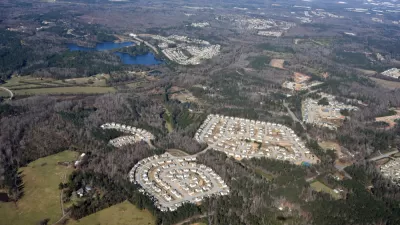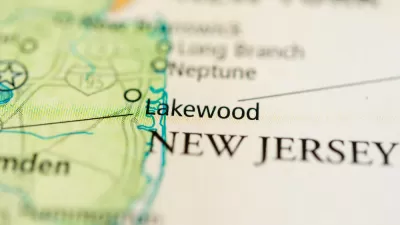A recent book on retrofitting sprawl contains numerous proposals to revise cul-de-sacs—all of which are interesting, even if politically infeasible.

In the excellent recent book Retrofitting Sprawl, a variety of authors address the challenges of making suburbia more walkable. The first half of the book discusses the challenges of altering the suburban status quo; for example, an essay by Julia Koschinsky and Emily Talen points out that only 18 percent of block groups in U.S. metropolitan areas have Walkscores over 70.
The second half focuses on ways to make these unwalkable places more walkable. And within this category, perhaps the most interesting essays focused on the problem of cul-de-sacs. Residents of these dead-end streets must walk far to reach nearby streets, because they need to go out of their way to find streets to connect with each other.
Three essays in Retrofitting Sprawl address this issue. Nico Larco's essay discusses pedestrian access to suburban shopping centers. Larco and his co-researchers studied such six areas in Oregon and Georgia, and discovered that residents of nearby residential blocks had created numerous informal ways of reaching nearby shopping areas, including unpaved paths that connect houses with each other, gates inserted by property owners, and holes cut in fences. Larco points out that the informal paths were quite worn, indicating that people walk even when the street system does not accommodate walking.
Compared to a normal sidewalk, these routes have numerous disadvantages. Unpaved paths are typically not accessible to the disabled or elderly, since they often contain water or soft mud that might be dangerous to people who are not very sure-footed. They are rarely well-lit, and thus might seem less safe than a typical sidewalk. Because they are near the backsides of commercial buildings, pedestrians must go out of their way to reach those buildings' front doors. Moreover, such informal paths are often not maintained at all, nor are they particularly permanent.
What, if anything, should planners do about these paths? One alternative would be to make these routes safer by paving and lighting them. Larco notes that this step might be impractical for two reasons. First, once landowners start to maintain nearby paths, they take on the risk of liability for inadequate maintenance should someone be injured on a path. And if cities tried to avoid this problem by taking over paths, they might occur significant expenses for land purchase. Second, paved paths might be subject to street design codes, and thus require expensive repair in order to comply with those codes. Because of these risks, Larco suggests that the best option for municipalities might be laissez-faire: cities should allow these paths to exist, but not regulate them or purchase them from landowners.
While Larco's essay focuses on connections between cul-de-sacs and neighborhood amenities, two essays focus on retrofitting cul-de-sacs themselves. One essay by Benjamin Stanley and several colleagues suggests turning a cul-de-sac into a mixed-use development. They use one seven-house cul-de-sac in suburban Phoenix as an example; they suggest transforming the houses into 31 apartments. Buildings at the edge of the cul-de-sac, closest to neighboring streets, would be set aside for shops, small offices, and daycare, thus giving cul-de-sac residents (and neighbors of nearby streets) useful destinations to walk to.
I find it hard to imagine anything like Stanley's proposal achieving fruition in my lifetime. To make it work, the seven current homeowners would all have to sell their property to one developer, who would turn their houses into apartments and offices. Even if all seven homeowners agreed to do this, their suburb of choice would have to approve a rezoning of the houses from single-family residential to commercial mixed-use—an unlikely development in today's political culture (which tends to oppose zoning changes).
Galina Tachieva's essay seeks to retrofit cul-de-sacs more gradually, by replacing houses with new structures one house at a time. For example, one house on a cul-de-sac could be replaced with a recycling center, then another with a small restaurant, then another with live-work units. Over time, a housing-only monoculture would be turned into a mixed-use (and thus walkable) neighborhood. This proposal seems to me to be even more politically infeasible than the Stanley plan; since some of the single-family houses on the cul-de-sac would still be occupied, their residents (as well as the residents of nearby blocks) might oppose the rezoning that would make nonresidential uses possible.
Ultimately, cul-de-sacs and residential blocks cannot be made mixed-use unless 1) existing zoning laws are reformed to limit government's power to veto redevelopment and 2) a change in American culture makes homeowners more tolerant of non-residential uses (thus making their political leaders to be more tolerant of redevelopment). Tachieva hints that such a change is possible in coming decades, writing that if the supply of homeowning seniors increases and the number of young families decreases, "[e]conomic factors … will prevent seniors from selling their large homes and mortgages when they wish to retire." But I'm not sure whether this factor will make seniors less fearful of new development or more fearful.

Trump Administration Could Effectively End Housing Voucher Program
Federal officials are eyeing major cuts to the Section 8 program that helps millions of low-income households pay rent.

Planetizen Federal Action Tracker
A weekly monitor of how Trump’s orders and actions are impacting planners and planning in America.

Ken Jennings Launches Transit Web Series
The Jeopardy champ wants you to ride public transit.

Philadelphia Is Expanding its Network of Roundabouts
Roundabouts are widely shown to decrease traffic speed, reduce congestion, and improve efficiency.

Why Bike Lanes Are Good: An Explainer for the US Transportation Secretary
Sean Duffy says there’s no evidence that bike lanes have benefits. Streetsblog — and federal agencies’ own data — beg to differ.

California Invests Additional $5M in Electric School Buses
The state wants to electrify all of its school bus fleets by 2035.
Urban Design for Planners 1: Software Tools
This six-course series explores essential urban design concepts using open source software and equips planners with the tools they need to participate fully in the urban design process.
Planning for Universal Design
Learn the tools for implementing Universal Design in planning regulations.
Ada County Highway District
Clanton & Associates, Inc.
Jessamine County Fiscal Court
Institute for Housing and Urban Development Studies (IHS)
City of Grandview
Harvard GSD Executive Education
Toledo-Lucas County Plan Commissions
Salt Lake City
NYU Wagner Graduate School of Public Service






























